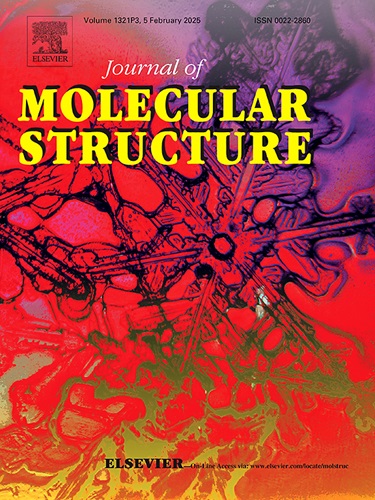A nonporous Cd(II) coordination polymer based on a new triangle imidazole‒carboxylic ligand for iodine adsorption and tetracyclic antibiotic detection
IF 4
2区 化学
Q2 CHEMISTRY, PHYSICAL
引用次数: 0
Abstract
A new Cd(II) coordination polymer (CP) based on (3,3′-(4-(4-(1H-imidazol-1-yl)phenyl)pyridine-2,6-diyl)dibenzoic acid (H2IPPDA), namely, [Cd(IPPDA)(H2O)]n (Cd-IPPDA), was constructed. It exhibits a two-dimensional coordination network with a (4·82) topology, and the 2D networks are packed into a 3D supramolecular framework via hydrogen bonds. Interestingly, Cd-IPPDA is capable of absorbing iodine molecules with a capacity of 3.4 g/g, although it has no significant pores in the framework. A mechanistic study revealed that the strong interactions between the iodine molecules and the framework cause the transformation from crystalline nonporous to porous amorphous structures. The resulting porous amorphous network, namely, a-Cd-IPPDA, still showed good iodine adsorption performance. It’s capacity was 3.0 g/g but adsorption kinetics significant increased, and could be reused for at least five cycles without a significant capacity decrease. In addition, the luminescence intensity of Cd-IPPDA was quenched by tetracyclines (TCs) in water; thus, this material can be used as a sensor for detecting TCs. The detection limits for OXY, CTE, and GEN are 0.51, 0.93, and 0.42 μmol/L, respectively. Moreover, the detection selectively is also good. The internal filtering effect and fluorescence resonance effect contribute to fluorescence quenching.
基于新型三角咪唑羧基配体的无孔Cd(II)配位聚合物用于碘吸附和四环抗生素检测
以(3,3 ' -(4-(4-(1h -咪唑-1-基)苯基)吡啶-2,6-二基)二苯甲酸(H2IPPDA)为基料,合成了一种新的Cd(II)配位聚合物(CP),即[Cd(IPPDA)(H2O)]n (Cd-IPPDA)。它具有(4·82)拓扑结构的二维配位网络,二维网络通过氢键封装成三维超分子框架。有趣的是,Cd-IPPDA能够以3.4 g/g的容量吸收碘分子,尽管它在框架中没有明显的孔隙。机制研究表明,碘分子与骨架之间的强相互作用导致晶体非多孔结构向多孔非晶态结构转变。得到的多孔非晶网络,即a-Cd-IPPDA,仍然具有良好的碘吸附性能。其吸附量为3.0 g/g,但吸附动力学显著提高,可重复使用至少5次,且容量没有明显下降。此外,四环素(TCs)对Cd-IPPDA的发光强度有猝灭作用;因此,该材料可用作检测tc的传感器。OXY、CTE和GEN的检出限分别为0.51、0.93和0.42 μmol/L。此外,选择性检测也很好。内部过滤效应和荧光共振效应有助于荧光猝灭。
本文章由计算机程序翻译,如有差异,请以英文原文为准。
求助全文
约1分钟内获得全文
求助全文
来源期刊

Journal of Molecular Structure
化学-物理化学
CiteScore
7.10
自引率
15.80%
发文量
2384
审稿时长
45 days
期刊介绍:
The Journal of Molecular Structure is dedicated to the publication of full-length articles and review papers, providing important new structural information on all types of chemical species including:
• Stable and unstable molecules in all types of environments (vapour, molecular beam, liquid, solution, liquid crystal, solid state, matrix-isolated, surface-absorbed etc.)
• Chemical intermediates
• Molecules in excited states
• Biological molecules
• Polymers.
The methods used may include any combination of spectroscopic and non-spectroscopic techniques, for example:
• Infrared spectroscopy (mid, far, near)
• Raman spectroscopy and non-linear Raman methods (CARS, etc.)
• Electronic absorption spectroscopy
• Optical rotatory dispersion and circular dichroism
• Fluorescence and phosphorescence techniques
• Electron spectroscopies (PES, XPS), EXAFS, etc.
• Microwave spectroscopy
• Electron diffraction
• NMR and ESR spectroscopies
• Mössbauer spectroscopy
• X-ray crystallography
• Charge Density Analyses
• Computational Studies (supplementing experimental methods)
We encourage publications combining theoretical and experimental approaches. The structural insights gained by the studies should be correlated with the properties, activity and/ or reactivity of the molecule under investigation and the relevance of this molecule and its implications should be discussed.
 求助内容:
求助内容: 应助结果提醒方式:
应助结果提醒方式:


